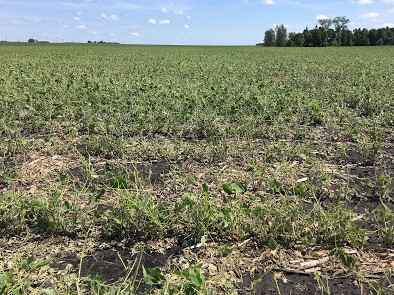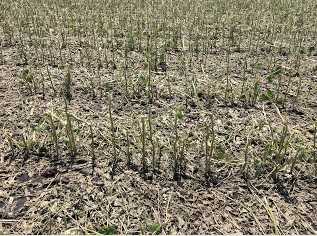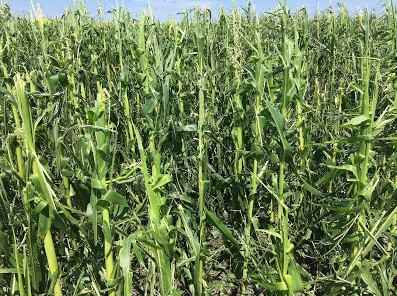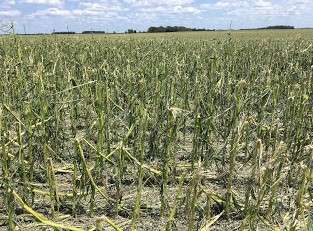By Seth Naeve and Dave Nicolai et.al
On Saturday July 11, 2020, a routine summer thunderstorm spawned severe weather across an exceptionally long streak in western Minnesota. With high winds and rain, a significant swath of large hail fell from near Willmar and continued into Nicollet County leaving devastated corn, soybean, and sugarbeet crops in a two- to six-mile-wide path. Hail as large as 2.5 inches in diameter was reported in areas of southwestern Minnesota as well, including a stretch in Jackson County, resulting in significant crop damage.

With an early planting season and unseasonably warm temperatures in late June and early July, the corn and soybean crops are developmentally more advanced relative to recent years. Most corn fields are tasseling and according to the July 13, 2020 USDA Crop Report, 21% of Minnesota corn fields are silking, which is 6 percentage points ahead of the 5-year average. Sixty-seven percent of soybeans are blooming, compared with 42% in the past five years and ten percent are setting pods, which is 5 points ahead of the average.
Farmers, consultants, agronomists, and insurance adjustors are asking about the prospects for a crop from damaged fields while trying to determine what actions to take next. Farmers should be in contact with their crop insurance representative before doing anything to a field to make sure the proper procedures are followed for coverage.
While replanting corn or soybean for grain yield is not realistic at this late date, the following resources contain useful information regarding crop yield loss estimates after hail damage:
Soybean
Survivability of soybean plants
Soybean plants with significant amounts of green leaf tissue remaining are likely to survive early-season hail damage, as they can regrow from axillary buds located at the juncture of the stem and leaves. Soybean plants entirely stripped of leaf tissue, however, will not recover. Similarly, larger plants with a small amount of green leaf material remaining are likely to recover but regrowth will likely be slow. Soybean plants with significant stem bruising may recover but will be more susceptible to lodging late in the season.
Estimating soybean yield loss
Soybean can tolerate low plant populations well and reductions in yield potential can be small across a wide range of stand losses. Populations near 100,000 plants per acre are likely to produce maximum yields, and those around 80,000 will yield about 90% of the maximum. Expected yield drops more rapidly when stands fall below 50,000 plants per acre. Stands of 40,000 plants per acre will likely produce about 75% of the normal yield. Note that the yield of a deficient stand will vary widely based on mid- and late-season weather conditions.
Research data
A three-year study in Lamberton, Minnesota and Ames, Iowa examined defoliation at the R1 and R3 stages at 33, 66 and 100 percent levels. Researchers also created a second, 66 percent defoliation treatment by thinning the existing 100,000 plant stand by 50 percent and defoliating by 33 percent. This allowed for a contrast between pure leaf loss and leaf loss with reduced stands.
As expected, more severe leaf loss led to greater yield losses and defoliation at the R3 stage produced a greater yield loss than at R1 (Table 1). Leaf loss of 66 percent resulted in only a 6 percent yield loss at the R1 stage, but when the same level of defoliation resulted from a combination of leaf loss and a 50% stand loss, yield losses increased to 21 percent. Total defoliation at R1 resulted in only a 25 percent yield loss while yield losses ballooned to 69 percent when plants were 100% defoliated at R3.
Late-season hail tends to reduce yields more than hail earlier in the season. Hail occurring in mid- to late-July will likely lead to yield losses similar to those seen at the R3 stage in this study. At the R3 stage, heavy hail events can cause 50 percent yield losses or more. Due to a shorter time for compensation, one should consider significantly thinned stands as additional yield loss.
Table 1. Soybean yield response to leaf defoliation and population thinning.
| Treatment | Yield | Yield gain or loss |
|---|
| Control | 51 bushels per acre | |
| 33% defoliation at R1 | 52 bushels per acre | +1% |
| 66 defoliation at R1 | 48 bushels per acre | -6% |
| 50% thin and 33% defoliation at R1 | 41 bushels per acre | -21% |
| 100% defoliation at R1 | 38 bushels per acre | -25% |
| 33% defoliation at R3 | 48 bushels per acre | -6% |
| 66% defoliation at R3 | 39 bushels per acre | -24% |
| 50% thin and 33% defoliation at R3 | 34 bushels per acre | -34% |
| 100% defoliation at R3 | 16 bushels per acre | -69% |
Replanting considerations and cover crop options
At this time replanting should only be considered in fields where the crop is a total loss AND replanted soybeans would be considered a cover crop for weed control and soil health. Soybeans planted in late July will yield MUCH below 50% of optimal IF they can reach maturity before the first killing freeze. Soybean maturities should be shortened by about 1.5 MG relative to the original stand.

Because replanting soybeans will not result in a net positive economic return, producers should consider all other viable options to control weeds on hail-damaged acres. Growers should carefully consider replanting costs, seed availability, weed control, and aesthetics. Growers should contact their seed suppliers as soon as possible to confirm that very early-maturity seed is still available.
Similarly, farmers should carefully examine cover-crop options, and compare expenses with potential benefits s and risks. A key decision a producer needs to make is whether or not they are interested in planting an overwintering cover or if they only wish to establish an annual cover for the remainder of the 2020 season. Winter covers provide many benefits to producers and there is plenty of time to get healthy cover established before fall. Summer annual covers should be established ASAP.
For more information, see articles on cover crop options for prevent plant acres and drown-out areas:
Corn
Survivability of corn plants
The keys to storm-related damage of corn fields are to: 1) be patient, 2) determine the crop growth stage, and 3) assess plant health accurately. Go ahead and view the damage, but do not make any assessments until 7-10 days have passed. It will take that long for the corn plant to begin growing again if it can.

Although hail affects yield primarily by reducing stands and defoliating the plant, defoliation causes most of the loss. Some comments on hail damage in corn from Dr. Joe Lauer, University of Wisconsin Extension Corn Specialist follow:
- After the tenth leaf stage, yield and stand reductions are on about a one-to-one ratio (eg. 80% stand = 80% yield potential) and are in addition to losses shown in the defoliation chart.
- Plants with bruised, but not severed stalks or ears will usually produce a near normal, harvestable ear.
- Growers should monitor stalk rot of severely defoliated plants which have a good-sized ear. Photosynthate will be mobilized towards the ear rather than the stalk. This could weaken the stalk and encourage stalk rot development. These fields may need to be harvested early to avoid standability problems.
- Nitrate levels in corn may become elevated, which could reduce animal performance. Growers with complete defoliation and high soil nitrogen levels (due to fertilizer, manure, or legume plowdown) should test nitrate levels and probably ensile the corn before feeding.
- Late season leaf loss will allow more light to penetrate to the soil and late-season weed growth may flourish.
Yield loss due to stand reduction is determined by comparing yield potential of the field at its original population with yield potential at its now-reduced population. Yield loss after silking is adjusted directly by determining the percentage of killed plants.
Estimating yield loss due to reduced population
Yield potential for corn at various plant populations is listed in Table 2. When gaps of two feet or more are present throughout the field, assume an additional 5% reduction in yield.
Table 2. Typical relationship between corn plant population and yield in Minnesota.
Population
(plants/A) | Grain yield potential
(% of maximum) |
|---|
| 36,000 | 100 |
|
| 34,000 | 99 |
|
| 32,000 | 99 |
|
| 30,000 | 97 |
|
| 28,000 | 95 |
|
| 26,000 | 93 |
|
| 24,000 | 91 |
|
| 22,000 | 88 |
|
| 20,000 | 84 |
|
| 18,000 | 80 |
|
| 16,000 | 76 |
Estimated yield loss due to leaf loss
As stated earlier, in corn most of the yield reduction due to hail damage results from leaf loss. To determine yield loss due to defoliation, both the growth stage of the field and the percent of leaf area removed from the plant must be determined (Table 3). Significant yield damage due to defoliation occurs around pollination during the tassel stage and silking.

The unfortunate timing of the July 11, 2020 storm is that some fields were just starting to tassel and pollination is expected to be severely impacted where damage was extensive. Any green leaf area remaining on a plant will contribute to yield if pollination was successful. Only consider leaf area to be lost if it is is removed from the plant or is brown and dead.
Table 3. Relationship between corn grain yield and leaf loss.
| | Percent leaf area destroyed |
|---|
| Corn stage | 20 | 40 | 60 | 80 | 100 |
|---|
| | percent yield loss |
| V18 | 7 | 15 | 33 | 56 | 84 |
| Tassel | 7 | 21 | 42 | 68 | 100 |
| Silked | 7 | 20 | 39 | 65 | 97 |
Managing a hail-damaged crop
For growers who choose to keep their existing crops, care should be taken to ensure that these fields produce as much as possible. Because the crop has been placed under tremendous stress, it is important to reduce the level of future stresses.
The most important and difficult challenge in hail-damaged crops often revolves around weed control. Maintaining good weed control in an open crop canopy is challenging. If you decide to replant soybean or plant a cover crop, minimizing soil disturbance can reduce weed germination and maximize the effectiveness of soil-residual herbicides already applied to the field. The expectation of heavy weed pressure should sway replant decisions slightly toward clean tillage and replanting if surviving stands are very poor.
While it is crucial to avoid further stress to a damaged crop, foliar fungicides are not likely to improve crop recovery and yield (see Do foliar fungicides provide a benefit to corn damaged by hail?). The most damaging diseases affecting corn and soybean after hail are bacterial, and a fungicide will have no effect on a bacterial disease.
Source : umn.edu